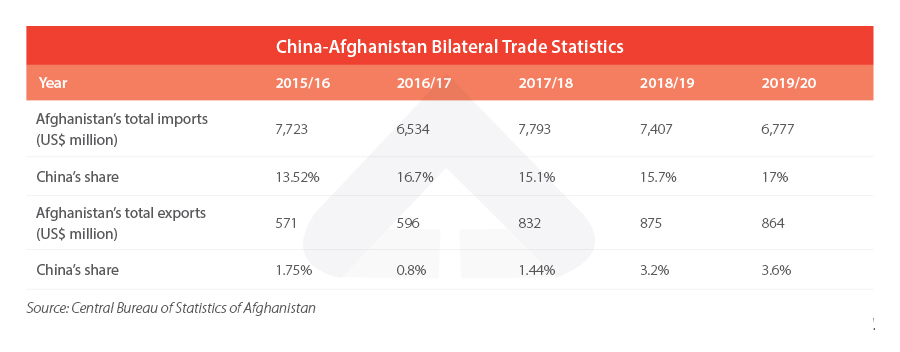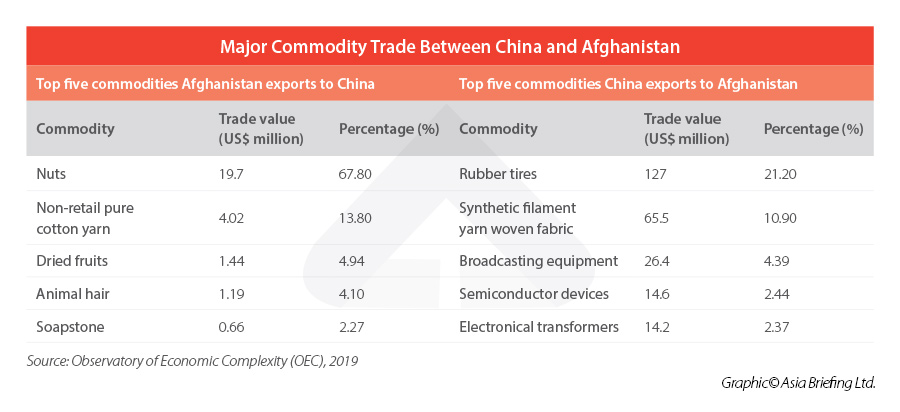China’s Future Trade And Development Intent With Afghanistan

By Melissa Cyril and Chris Devonshire-Ellis
China’s bilateral trade with Afghanistan is on track to overtake by 2024 the volume the United States managed over 20 years with an investment of US$2.26 trillion
While the current situation in Afghanistan is obviously currently unstable, in this article we examine the role that China has had until now in developing bilateral trade and where the trends are. Despite the current problems, Afghanistan is home to some of the largest untapped reserves of rare earth metals in the world.
Afghanistan’s peace and stability is thus of great interest to China. As the US withdraws its troops from the region along with NATO, the world is curious about China’s role in brokering the peace process.
In a recent press conference, China’s Foreign Minister Wang Yi stressed that Beijing “would not interfere in the internal affairs of Afghanistan” but urged the country’s various factions to work to avoid expansion of the conflict, restart intra-Afghan negotiation, and prevent other terrorist groups such as Al Qaeda from taking advantage of the current struggles for control.
Wang also called upon the Taliban to “recognize its responsibility toward the country and the nation, make a clean break with all terrorist forces and return to Afghanistan’s political mainstream with a sense of responsibility for the country and the people”.
It is likely that China will take a pragmatic approach to building relations with Afghanistan, willing to cooperate with the authority that is best situated to protect China’s domestic and regional interests.
China has previously engaged in dialogue with the Taliban, who have now occupied nearly all territories across Afghanistan including, crucially, the Badakhshan region on the border with China.
The Taliban appear eager to assure the Chinese government that their rule would not affect China’s stability and have said they welcome Chinese investments in Afghanistan. China also has close ties with Afghanistan’s neighbor, Pakistan, which could facilitate future regional trade and investment.
Although the course of Afghanistan’s near future remains to be seen, it is likely China will participate in the reconstruction efforts.
China-Afghanistan relations
China established diplomatic relations with Afghanistan in 1955, and the two countries have generally maintained friendly relations throughout history. Both countries currently have embassies in their respective capitals.
Since 2001, China has kept a relative distance, refusing to put boots on the ground, but on occasion providing financial and military assistance to the Afghan central government.
In 2017, China began engaging in peacekeeping efforts between Pakistan and Afghanistan following deteriorating relations between the latter two countries. The three nations agreed to establish China-Afghanistan-Pakistan trilateral cooperation and held their first trilateral dialogue in late 2017.
In their fourth trilateral dialogue, held in June 2020, they reiterated their willingness to expand peace and stability in the region, and reaffirmed their commitment to deepening cooperation under the Belt and Road Initative. The three countries also confirmed their willingness to strengthen cooperation in tackling the COVID-19 pandemic and fighting terrorism.
It bears mentioning that the Afghan representative at these dialogues is the minister of foreign affairs of the Islamic Republic of Afghanistan, which is currently ruled by a coalition government. It is uncertain how these talks will develop now the Taliban (who refer to themselves as the Islamic Emirate of Afghanistan) have taken effective power and are about to form a government.
Why Afghanistan holds importance to China’s strategic interests
From China’s vantage point, Afghanistan enjoys a strategic geographic position, offering a potential short-cut for imports of oil and gas from the Middle East, along with neighboring Pakistan.
China is therefore keen to expand cooperation under the BRI and build trade and transport routes involving Afghanistan. However, previous BRI projects in Afghanistan have faced security risks, leading to some projects, such as a copper mining contract signed with the Chinese state-owned company MCC, failing to ever get off the ground.
It is clear that any expansion of BRI projects in Afghanistan, and by extension bilateral trade relations, are likely to face significant hurdles as long as the internal situation remains unstable. China is therefore likely to continue using its significant influence in the region to push for peace and stability.
Trade flow between China and Afghanistan
Afghanistan’s main trading partners are its neighbors, and China is one of its largest trading partners. In 2019, China was the fifth-largest export destination for Afghan goods, after the United Arab Emirates (UAE), Pakistan, India, and the US. It was also the fourth-largest source of imported goods for Afghan markets, following UAE, Pakistan, and India. Although trade volumes remain small, it should be noted that over the past 20 years, Chinese exports to Afghanistan have increased at an annualized rate of 13.1%. In 2019, China exported US$600 million of goods to Afghanistan, while Afghanistan exported US$29.1 million to China.
In contrast, the United States exported goods worth US$758 million in 2019 to Afghanistan and imported goods worth US$39 million. One thing 20 years of US occupation in Afghanistan did not do was to boost trade or seek to improve economic livelihoods. China’s approach will be to concentrate on the latter. In three years, by 2025 given the current trends, Chinese trade with Afghanistan is likely to overtake anything that the United States managed to achieve, even with a Washington calculated expenditure into Afghanistan of some US$2.26 trillion since 2001.
It should be noted that the United States also holds 21.9 tonnes of Afghan gold reserves worth about US$47 billion belonging to the Afghan Central Bank that it has refused to permit the Taliban or any future Afghan Government access too.

Over the last five years, China’s share in Afghanistan’s total imports and exports has been growing, as shown in the above table. Especially, the annual growth rate in the value of Afghanistan’s exports to China between 2016 to 2020 reached 105 percent, according to the International Trade Centre (ICT).
China sells electronics, pharma drugs, machinery, and textile and clothing to Afghanistan and buys agricultural goods from the country.
In 2019, the main products that Afghanistan exported to China were nuts, non-retail pure cotton yarn, dried fruits, animal hair, and soapstone. In return, China mainly exported rubber tires, synthetic filament yarn woven fabric, broadcasting equipment, semiconductor devices, and electronic transformers to Afghanistan.

Trade agreements between China and Afghanistan
China and Afghanistan haven’t signed any free trade agreements (FTAs) or double taxation avoidance agreements (DTAs) as the present. However, the two sides have established the China-Afghanistan Joint Committee on Economics and Trade (JCET), which was held in 2010, 2015, and 2017.
In August 2014, China and Afghanistan signed the Exchange Notes on Granting Zero-Tariff Treatment to the Exports of Some Afghan Goods to China. Since 2015, 97 percent of goods originated from Afghanistan can enjoy zero-tariff when exported to China. However, Afghanistan imposes relatively high tariff rates on raw material imports.
Multilateral engagement efforts
Belt and Road Initiative
As the US exits its strategic presence in Afghanistan, Chine senses both risks and opportunities. Lying at the intersection of South Asia, Central Asia, and West Asia, Afghanistan is significant to China’s BRI projects. Once the political situation is stable and the necessary infrastructure is in place, the country has great potential to develop into a key regional trade hub.
China would also be keen to extend the China-Pakistan Economic Corridor (CPEC), a flagship BRI project, to Afghanistan. Launched in 2013, CPEC is focused on the construction of key infrastructure, including upgrades to the cross-border Karakoram Highway and the construction of the New Gwadar International Airport in Pakistan’s southern Balochistan province.
Chinese leaders have reportedly already been negotiating a deal with Kabul authorities to invest in Afghanistan’s infrastructure under the BRI. Previously, Kabul was hesitant to approve deals with Beijing given how the US was heavily involved with the Afghan government. Now, the Taliban have been in discussions with Beijing concerning the extension of the US$62 billion CPEC into Afghanistan.
Shanghai Cooperation Organization
Afghanistan started to engage with the Shanghai Cooperation Organization (SCO) in 2005 by signing a protocol establishing the SCO-Afghanistan contact group. In 2012, Afghanistan became an observer in the SCO and has been striving to get full membership since 2015. At present, this application hasn’t been approved and Afghanistan is still an observer in the SCO, though Pakistan and India gained full membership in July 2017.
Afghanistan is geographically part of the SCO region and has close historical and economic relations with most SCO states. Practically speaking, the Afghan Civil War was a major reason for the formation of the SCO in the first place. Afghanistan and the SCO have common interests in the restoration and maintenance of regional security by combating terrorism, extremism, and opium cultivation.
As mentioned earlier, any future opportunity transpiring between China and Afghanistan will rely heavily on the security situation of the region. In this regard, the SCO could play an important role for cooperation and joint development.
Summary
With a diminishing US presence and the evolving security paradigm in Afghanistan, the importance of the country in Beijing’s foreign policy thinking has increased. A stable Afghanistan would aid China in its long-term economic plans in the Central Asian region. Therefore, China has the political will to push for peace and stability in Afghanistan. Despite facing upheavals and the halting of projects, Afghanistan’s vast amount of minerals and hydrocarbons remain attractive to Chinese investors and companies. In turn, as Kabul actively seeks foreign assistance to help its weak economy, Beijing’s economic clout makes it a preferred partner to work with. Infrastructure development costs can be offset by selling mining and other rights and getting Afghanistan workers back to productivity.
China and Afghanistan are important trading partners for each other, and this relationship has potential to grow and diversify. China’s continuous market opening also serves up opportunities for Afghani exporters and businesses.
Regional businesses should keep an eye on developments in the region to mitigate the risks caused by geopolitical complexities. If the security situation in the region becomes clearer and more certain, there would be substantial scope for growth in bilateral investment and regional trade momentum.
Related Reading
About Us
Silk Road Briefing is written by Dezan Shira & Associates. The firm has 28 offices throughout Asia, and assists foreign investors into the region. For strategic advisory and business intelligence issues please contact the firm at silkroad@dezshira.com or visit www.dezshira.com





